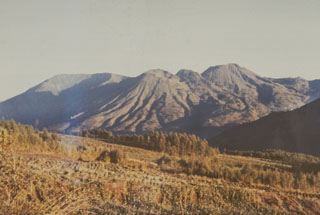Report on Dieng Volcanic Complex (Indonesia) — April 1992
Bulletin of the Global Volcanism Network, vol. 17, no. 4 (April 1992)
Managing Editor: Lindsay McClelland.
Dieng Volcanic Complex (Indonesia) Sudden gas emission kills one person and hospitalizes two others
Please cite this report as:
Global Volcanism Program, 1992. Report on Dieng Volcanic Complex (Indonesia) (McClelland, L., ed.). Bulletin of the Global Volcanism Network, 17:4. Smithsonian Institution. https://doi.org/10.5479/si.GVP.BGVN199204-263200
Dieng Volcanic Complex
Indonesia
7.2°S, 109.879°E; summit elev. 2565 m
All times are local (unless otherwise noted)
A sudden gas emission occurred at about 1600 on 18 March from a fractured and altered zone in a river valley 200 m W of Sikidang Crater. After the gas emission, one person was found dead in the stream, and two others were hospitalized after trying to rescue him. Surface gas measurements the next day indicated high concentrations of CO2 and O2 (40 and 15 weight %, respectively), and lesser concentrations of H2S and HCN (200 and 197 ppm, respectively).
Steam emission continued from Sileri Crater (~3 km NNW of Sikidang), rising 40-60 m in mid-April. An average of one A-type and seven B-type volcanic earthquakes were recorded daily during mid-April, an increase from earlier in the month.
Geological Summary. The Dieng plateau in the highlands of central Java is renowned both for the variety of its volcanic scenery and as a sacred area housing Java's oldest Hindu temples, dating back to the 9th century CE. The Dieng Volcanic Complex consists of multiple stratovolcanoes and more than 20 small Pleistocene-to-Holocene craters and cones over a 6 x 14 km area. Prahu stratovolcano was truncated by a large Pleistocene caldera, which was subsequently filled by a series of cones, lava domes, and craters, many containing lakes. Lava flows cover much of the plateau, but observed activity has been restricted to minor phreatic eruptions. Gas emissions are a hazard at several craters and have caused fatalities. There are abundant thermal features and high heat flow across the area.
Information Contacts: W. Modjo, VSI; T. Casadevall, USGS.

